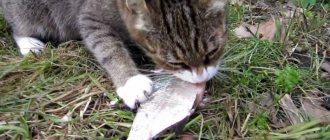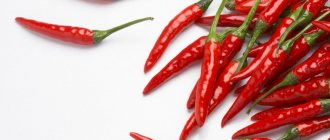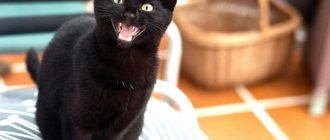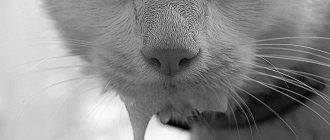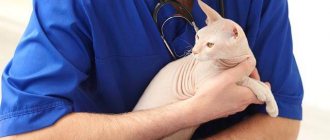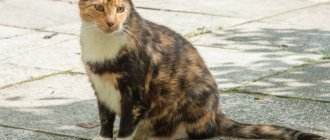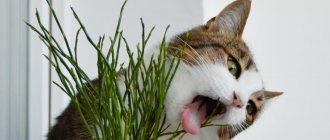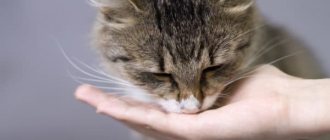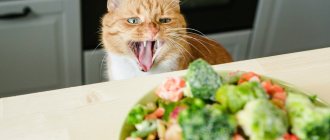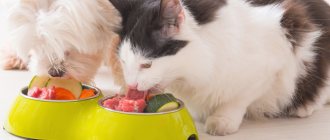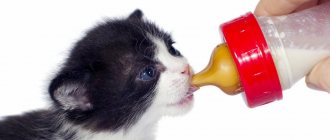Some cats, despite comfortable living conditions and round-the-clock access to food bowls, face the problem of being underweight. Thinness can occur suddenly or be an innate property of the animal. One way or another, when you look at such an individual, you want to immediately provide it with food in order to bring it to a “normal” state. But how to feed a cat so that increasing portions does not affect the health of the pet?
How to fatten a cat
This question is not as simple as it seems, since more food does not always solve the problem. In addition, several more equally important dilemmas are added to the question of fattening. How to determine where healthy weight ends and painful underweight begins? How to determine the condition of a cat? All breeds have different norms and pathologies, which is why the owner can easily become confused. We will talk further about the causes of thinness and methods of combating it.
Causes of exhaustion
There are many causes of exhaustion that cannot be covered in this article. The simplest and most concise classification of causes is presented below.
Physiological
Physiological reasons include weight loss due to circumstances in which the cat could not fully satisfy its nutritional needs. This applies to stray cats, cats in heat, and cats experiencing prolonged stress. Physiological exhaustion is also typical for cats that have fattened a large litter and given all their energy and nutritional resources to their offspring.
Both cats and female cats change their behavior during the period of sexual heat, sometimes forgetting about food
As you can see, the causes of physiological exhaustion are exogenous; they are tied to the specific environment with which the cat interacts.
Thus, a stray cat can be brought into order with the right diet, a cat experiencing stress can be calmed down. The mother, who fed the family, is fed back to a healthy state. Among other things, some breeds have a predisposition to thinness - Sphynxes, Ukrainian Levkoys are difficult to fatten, which is also due to their peculiar bodily constitution.
Some breeds do not need fattening, being thin by their constitution
Pathological
Pathological causes include malfunctions in the pet’s body itself. No matter what comfortable and stabilizing conditions a cat with pathological thinness finds himself in, his condition will not change. The causes of such exhaustion can be both acquired and congenital diseases.
Refusal to eat caused by internal pathologies requires a diagnosis and selection of a treatment regimen.
To feed such a fragile pet, you must first undergo an examination with him at the veterinary clinic. The test results will show the cause of problems with weight gain and the veterinarian will develop a diet that is suitable for your pet. It is not recommended to act as a nutritionist on your own for cats with pathological thinness, since the likelihood of complications is high.
Supplements and vitamins – are they necessary?
The need to add vitamins depends on the type of diet. With dry feeding, all the necessary substances are already present in the composition, so additional elements can cause a surplus.
The opposite situation is typical for natural feeding. In this case, vitamins simply must be present in the diet. But even here you can provoke their excess by trusting the advice of friends. It is better to clarify this question with a veterinarian, who will select a ready-made complex for your pet based on the test results.
How to understand how much weight a cat has?
Despite the fact that it is difficult to mistake an emaciated cat for a well-fed one, as well as vice versa, there are nuances and transition states that it is advisable to pay attention to. Thus, gradual weight loss may be an indicator of a developing disease. Weight gain may indicate an incorrect diet and disproportionately large portions.
Table 1. Weight categories for cats
| Underweight | Normal weight | Excess weight | Moderate obesity | Severe obesity |
| Bones (especially the pelvic bones and ribs) show through and are visible to the naked eye in smooth-haired and hairless individuals | The animal has the correct proportions; when viewed from above, the cat's body takes on the shape of an hourglass. | Fat accumulates primarily in the back, abdomen and face | The bones are indistinguishable and can barely be felt. The fat layer appears in the abdomen, chest and beginning of the tail | Pronounced accumulations of fat in the back, base of the tail, chest and abdomen |
| Lack of fat on the chest and ribs | The ribs have a thin layer of fat, but are easily palpable | The ribs can be felt but not visually identified | The ribs can only be felt when pressing | The ribs and spine are indistinguishable under a layer of fat |
| No belly fat | A small amount of belly fat | Marked abdominal fat when viewed from the side | When viewed from the side, accumulations of fat on the abdomen are noticeable | The belly sag noticeably due to fat |
| The waist is sharply defined due to the sunken belly | The waist is distinguishable, but does not provide a clear contrast with the ribs | The waist is vague, the body shape resembles a rectangle | The waist is almost indistinguishable | When viewed from above, the waist forms a circle, making the cat look like a bowling pin. |
Cat weight on a scale of ten
The vast majority of cats grow and gain weight before they reach one year of age. They develop especially quickly during the first six months, gaining on average 150-200 grams daily. Over the next six months, the kittens develop their body structure and develop sexual differences, ending by the age of one year. Of course, each breed has its own optimal weight. Maine Coons will likely be heavier than Miniature Munchkins and Sphynxes.
Different breeds have their own weight standards
The average mongrel cat weighs from three to six kilograms. The cat is inferior to him in weight by 1-3 kilograms. However, even outbred cats have different skeletons. The expression “broad bone”, in addition to an ironic connotation, also has a completely serious meaning. Different cats with different bone structure and thickness have different weight standards. With the same 5 kilograms of weight, we can observe both a plump and a fit individual.
Weight categories of cats depending on breed
Therefore, one of the main signs of thinness-fullness is the ability to palpate or visually identify the ribs and chest. The more difficult it is to do this, the greater the deviation of the animal’s weight towards fullness.
When to contact a veterinarian
If you are not sure about the cause of exhaustion, sign up for an examination. Taking tests and undergoing an ultrasound will never be superfluous. If there are no alarming symptoms, you can postpone the visit for a couple of days to observe the pet’s behavior.
You should not delay contacting a veterinarian only if your condition steadily worsens, you refuse to eat for more than 2 days, and you lose too much weight. Particular attention should be paid to kittens. They should not fast for more than a day, so a small pet should be taken for examination immediately after a deterioration in appetite.
The main mistakes when planning your diet
I would also like to touch upon the topic of mistakes in feeding pets, made by owners with the best intentions. Despite the fact that each owner chooses his own intuitive diet plan for his pets, one can notice repeated and very sad “rake”, which people regularly continue advance.
Some cat owners believe that the doses of dry food indicated on the packaging are too small for their cats; some overfeed their pets with all types of meat, being confident in its clear benefits.
Sometimes an abundance of healthy food can cause various ailments
Complications with digestion or hair that arise later in an animal sometimes cause genuine surprise among the owners and a lack of understanding of their role in the resulting illness. We’ll talk about how to recognize your mistakes in planning your cat’s nutrition and stop them in time.
Common mistakes in feeding cats
What natural foods to feed your cat to make her gain weight
When fattening, you should avoid too fatty foods (pork, lard, cream) and feeding from the human table. Such food worsens the functionality of the gastrointestinal tract, causing new complications.
The main emphasis should be on calorie content, choosing foods with high energy value. It is recommended to include in the menu:
- chicken, rabbit, lamb and veal, containing large amounts of animal protein;
- boiled vegetables (zucchini, pumpkin, carrots), bran and oatmeal, enriched with fiber;
- sea fish, offal, chicken and quail yolks, characterized by a wide variety of vitamins and minerals in their composition;
- fermented milk products with low fat content, which have a beneficial effect on the functioning of the cardiovascular system and the musculoskeletal system;
- jellied cartilage, containing collagen beneficial for joints;
- buckwheat and rice porridge, which normalize peristalsis and digestion.
Instead of milk, it is better to use artificial milk formulas from a pet store. Otherwise, your pet may have digestive problems.
Table: comparative characteristics of dietary feeds of various brands
| Name of food | Class | View | Flavors | Peculiarities | Price |
| Eukanuba Adult Sterilized Weight Control Chicken | Superpremium | Dry | Chicken | Designed for sterilized and neutered male cats |
|
| Hill's Prescription Diet Metabolic Weight Management | Superpremium | Dry | Chicken | Allows you to maintain optimal weight |
|
| Hill's Prescription Diet Metabolic Urinary Weight Care | Superpremium | Dry | Chicken, turkey | Also used for cats with urinary tract diseases |
|
| Hill's Prescription Diet i/d Digestive Care (jelly) | Superpremium | Wet | Chicken | Helps maintain a healthy digestive tract |
|
| Hill's Prescription Diet w/d Digestive/Weight Management | Superpremium | Dry | Chicken | Helps normalize weight in diabetic cats |
|
| Hill's Prescription Diet w/d Digestive/Weight Management (jelly) | Superpremium | Wet | Chicken | Better absorbed by the pet's stomach |
|
| Royal Canin Satiety Weight Management SAT34 | Superpremium | Dry | Chicken, poultry | Can be used for diabetes and urolithiasis |
|
| Royal Canin Neutered Adult Maintenance | Superpremium | Wet | Chicken, pork, poultry, liver | Suitable for sterilized animals in the postoperative period |
|
| Pro Plan Veterinary Diets Feline OM Obesity (Overweight) Management dry | Premium | Dry | Chicken, poultry | Used for adult cats |
|
| Farmina Vet Life Natural Diet Cat Obesity | Premium | Dry | Chicken, pork, poultry | Prevents muscle loss | 2 kg - 1709 rub. |
| Royal Canin Satiety Weight Management (jelly) | Superpremium | Wet | Chicken | Suitable for pets with diabetes |
|
| Purina Pro Plan Veterinary Diets OM pouches | Superpremium | Wet | Chicken | Helps maintain weight |
|
| Happy Cat Adipositas | Superpremium | Dry | Chicken, poultry | Also used for cats with liver disease |
|
| Brit VDC Obesity | Superpremium | Dry | Chicken | Suitable for British cats, grain free | 2 kg - 1240 rub. |
| Forza10 Active Line | Superpremium | Dry | Fish | Consists of heart-shaped granules | 454 g - 470 rub. |
| Enova Breeder Cat Light Indoor | Superpremium | Dry | Chicken, rice | Can be used to feed cats over 7 years of age | 10 kg - 6300 rub. |
| Bosch Sanabelle Light for cats prone to obesity | Superpremium | Dry | Bird | Provides quick satiety due to the large amount of dietary fiber | 2 kg - 1300 rub. |
| Barking Heads Adult Fat Cat Slim | Holistic | Dry | Chicken, salmon | Suitable for pets with sensitive stomachs |
|
| 1st Choice Weight Control | Superpremium | Dry | Chicken | Designed for adult animals | 5.5 kg - 2600 rub. |
Is fattening required?
How can you tell if a cat is thin, has a normal weight, or is “fat”? First of all, there are a number of important points to note:
- The owner should not compare it with the pets of friends, neighbors, or close relatives. After all, in this matter there is individuality. Even 2 kittens from the same litter can have different constitutions: 1 is excessively thin, and the second is well-fed.
- If we are talking about purebred pets, then there are certain standards. Typically, the table indicates both minimum and maximum data - height and body weight.
- If the cat is of “noble” origin, then you will have to navigate “by eye,” or rather, by touch. The animal should be placed in a standing position - the front legs are straight, the hind legs are slightly pulled back, in the direction of the tail. You need to feel his spine, it should be smooth. While stroking your pet, the outer ribs should not be felt, and this is considered normal. Then the pelvic part is palpated - a moderately well-fed animal has a smooth croup, with slightly protruding knuckles. The abdomen may be taut or slightly saggy. When moving, a fold forms in the peritoneum area - this is also normal. There is a thin layer of fat on the sternum and abdomen that can be felt.
As a rule, even skinny representatives of the species develop a small layer of fat in the cold season.
External signs of thinness. A pet can be called thin if it has:
- the spinal column and ribs are visible upon visual inspection;
- the hip joints clearly protrude into tubercles;
- a depression is noticeable in the area of the peritoneum;
- the muscles of the forearms, hind limbs, and sternum “fall off.”
The constitution and muscle tone of the animal are always taken into account. Many of the cats appear thin in appearance, but at the same time they have developed muscles.
We make a calculation.
It is impossible to calculate the “ideal” weight of a pet using mathematical calculations of coefficients or a formula.
For example, the standard weight of “British women” varies from 4.2 to 6.8 kg. However, there is a recorded case where a male of this breed reached a weight of just under 14 kg. At the same time, he was physically healthy, although the giant was still excluded from breeding (read in the article how much a cat should weigh depending on breed and age).
The dangers of excessive fattening
For those owners who want to fatten their pet for their own aesthetic needs - to admire how funny the cat licks or runs - it is useful to learn about the consequences of feline obesity. Since obesity in cats, like in humans, is a disease, a fat cat will sooner or later face health problems, including:
- Diabetes of the second type - being initially not prone to diabetes, your pet can develop it with an incorrect lifestyle and, in particular, nutrition. As a result, the owner will have to periodically inject insulin into the cat in order to avoid a sharp deterioration in his health;
Diabetes is one of the most dangerous consequences of overfeeding a cat.
Gaining excess weight is fraught with heart attacks leading to heart attack
Overweight cats have a more difficult time recovering from fractures due to the heavy load on the joints.
In advanced cases, arthritis can only be treated with a surgical scalpel
How to fatten a cat without it being fat
When fattening, it is important not to overdo it, as obesity can cause even more problems. To do this, be sure to control the growing indicator and avoid the most common mistakes.
Weight control
Weigh your pet on a floor or kitchen scale every week. If you gain too quickly, adjust your daily caloric intake or add more activity.
What mistakes should you avoid?
Self-feeding is often accompanied by mistakes. For the safety of your pet, try to avoid sudden changes in diet or mixing different types of food, handouts from the table, uncontrolled eating and infrequent feeding. All these situations can lead to indigestion or obesity.
Beef
Meat is a source of protein. If you really want your pet to please you for many years, you should try to include boiled beef in its diet.
Raw meat can be given only frozen to reduce the risk of infection with worms. When thinking about how to fatten a cat, you must remember to give him beef. You will see how the coat changes and greater physical activity appears. If an animal eats properly, it will look the part.
Recommendations
Often the owner does not have time to select natural ingredients for the pet’s diet. There are many reasons for this. Some breeders are inclined to feed dry food, citing the fact that manufacturers balance their product as much as possible. In fact, one jar contains a whole range of vitamins, minerals and supplements.
Of course, this applies to expensive food. Let's look at some companies that are recommended by experts and other breeders. The owners decide whether to use them or not. Dry food is convenient to store, easy to dose and, in most cases, pets like. Let's designate the top 3 dry food for use:
- Royal Canin Gastro Intestinal Moderate Calorie. Quite often prescribed by veterinarians. This is, in fact, a whole complex that allows you to put an emaciated animal back on its feet. It contains the necessary proteins, beet pulp, fish oil and even rice. There is an opinion that it is intended for obese cats. But this is not entirely true. A properly balanced diet allows you to both gain weight and lose weight.
- Hill's Science Plan Perfect Weight. The second food option, which is used for both weight loss and weight gain. This is quite normal, because... obesity is more common in domestic cats than thinness. The substances are selected to balance the digestion process and improve the absorption of nutrients. A minimal amount of fat will prevent stress on the liver and improve the absorption of nutrients.
- Acana Orijen SIX FISH. Complete, balanced food, which mainly consists of fish (perch, flounder, hake, sardine, herring). Less than half is protein. It contains not only fillet, but also by-products such as bones and entrails. This allows you to additionally saturate the feed with phosphorus, magnesium, zinc, calcium and other substances.
The addition of freeze-dried liver makes the product very attractive to cats. Many experts and breeders note that it is the smell, which is not created due to any additives, that gives the food such a desirable status among domestic animals.
Let's look at three wet foods that will also have a beneficial effect on the animal's weight. Let's stick to canned food. Obviously, wet food will allow you to gain weight much faster:
- Royal Canin Recovery. Canned food with a convenient key is often used during the rehabilitation period after a serious illness. Although there are some restrictions when using it. For example, with pancreatitis, hepatic encephalopathy, hyperlipidemia. The food encourages the consumption of water, which also has a beneficial effect on weight gain.
- Royal Canin Convalescence Support Cat. The basis of the food is pork, chicken, and pork liver. Consumers note rapid weight gain, increased activity, normalization of immunity and appetite. The food is also used during rehabilitation after a serious illness.
- Applaws Chicken & Duck. Canned food consists of 80% meat, which is cooked in its own broth. The product contains chicken and duck fillet, rice, broth. It is the composition that is as close as possible to natural nutrition that attracts consumers. Cats eat canned food with pleasure and quickly gain weight.
To gain weight, it is better for kittens to use wet food, because... Dry granules cannot always be chewed by your pet.
Additional measures
Unfortunately, mustachioed striped animals often find themselves in dangerous situations and their emaciation leads to pathological changes in eating behavior. It is often necessary to awaken a cat's interest in food before feeding it. There are several means for this:
- Vitamins . You should choose a suitable vitamin complex for your pet, which will help restore the animal’s body and provide it with useful substances. Cats are not always happy to take vitamin supplements. But even if the pet resists, the owner should be persistent. Tablets or dragees can be crushed to a powder state, diluted with water and poured into the cat’s mouth using a syringe without a needle. Also, drugs in solid forms can be crushed and mixed with food.
- Beneficial bacteria . It is recommended to give your pet probiotic products consisting of bifidobacteria and lactobacilli 30 minutes before meals. They normalize the intestinal flora, suppressing the activity of microbes that cause dysbiosis. In addition, lactobacilli are involved in strengthening the immune system, which is important for both sick and healthy pets. The most useful probiotics that have a positive effect on the animal’s intestinal microflora: Bifitrilak, Zoonom, Subtilis, Enterol, Lactobifadol, Olin, etc. It is allowed to use drugs from a regular pharmacy, for example, Lactobacterin, Bifidumbacterin.
Fermented milk products
Fresh cottage cheese, kefir, and fermented baked milk must be present in your pet’s diet. Milk, contrary to popular belief, is not recommended for cats. The fact is that it is learned only by babies. An adult may experience gastrointestinal upset.
If you try to feed your pet correctly, he will be at his ideal weight. Fermented milk products are generally very beneficial for the health of both humans and animals.

